Split Xml Into Multiple Files Using Xslt

Nov 17, 2013 Hey experts, I have an XML file as input, and i use XSL to transform it to another custum xml called OIOXML. Ama Manual Of Style 10th Edition Endnote Torrent. And i'm able to use the function for-each to. Mar 20, 2012 The files Need to download. Split large XML to Smaller XML using XSLT. I would like to split XML file into multiple of smaller number of.

Oleg Tkachenko Multiconn Technologies June 6, 2003 Summary: Guest author Oleg Tkachenko explains how you can postprocess XSL transformation results into multiple documents using the XslTransform and XmlTextWriter classes in the.NET Framework. (17 printed pages). Note This download requires that the be installed. Editor's Note This month's installment of Extreme XML is written by guest columnist Oleg Tkachenko. Oleg lives in Holon, Israel and is a Software Engineer for Multiconn Technologies. He has been working closely with XML, and especially XSL for the last three years, and he is an active contributor to the online community surrounding Microsoft XML products. He can be reached.
As far back as people have asked for the ability to produce multiple output documents in one XSL transformation. It's fairly natural indeed to be able to perform not only one-to-one or many-to-one, but also one-to-many as well as many-to-many transformations. For instance, to produce separate HTML pages for each chapter of a book or to generate a Web photo gallery from an image catalog and a page template. Unfortunately the, which was published back in November 1999, does not define support for multiple output documents; instead a single result document is assumed. The W3C XSL Working group has that the next version of XSLT language would support multiple output documents and accordingly the (officially frozen) has introduced a notion of a in order to meet this requirement. (work in progress) has gone even further—the concept of a principal and subsidiary result documents has been removed and all possible result documents have been given equal status. So although the story sounds promising for future versions of XSLT, current users of XSLT 1.0, such as users of the class or MSXML, do not have access to this functionality.
To workaround this lack of functionality, a number of alternate solutions are usually recommended in XSLT-related including: • Preprocessing of the transformation input by breaking it into chunks and performing the transformation on each chunk in turn. • Creating and writing them aside using extension functions or extension objects. • Postprocessing of the transformation result by splitting it into chunks and writing each chunk as a separate document.
Comments are closed.